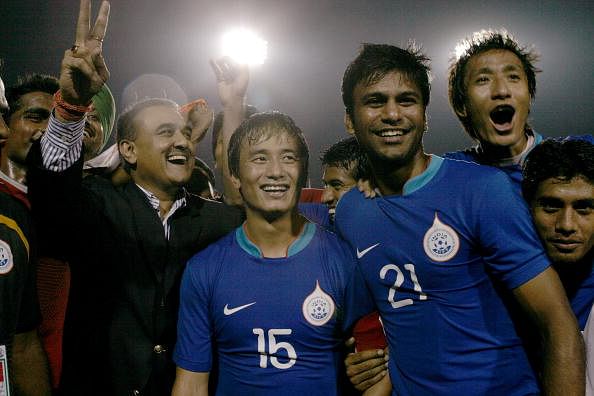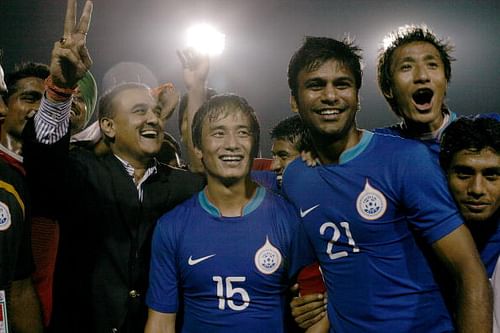
Remembering India’s Asian Cup 2011 campaign: Abhishek - the target man

Abhishek Yadav (wearing jersey number 21)
Indian strikers are a neglected breed in the I-League due to the over reliance of clubs on foreign strikers. It is understandable from the club’s point of view, as they invest a lot of money on foreigners. But for Indian the forwards, it is a nightmare as they hardly get to play regularly.
As a result, it becomes almost impossible for the national coach to find strikers for the national team. So the ones who do make it eventually, are exceptional. Abhishek Yadav is one such example, as his performances at Mahindra United earned him a call up to the national team at the age of 22 during Stephen Constantine’s tenure.
He is best remembered for that winning goal in the 2002 LG Cup final against hosts Vietnam, which gave India their first real international success on foreign soil since the bronze medal at the 1970 Asian Games.
Nine years on, Abhishek was still part of the senior squad under Bob Houghton. He was a senior player but the goals had dried up and his inclusion in the team was criticised heavily by sections of the media.
But Abhishek’s height and physical presence was an integral part of Houghton’s direct style of play. With Bhaichung Bhutia struggling with injury problems, the English coach needed a proper partner for Sunil Chhetri. The Mumbai lad gave a reminder about his abilities with a strong showing in the 3-6 friendly defeat to Yemen, a match in which he also scored a rare international goal.
However, in the first game of the Asian Cup 2011, it was Mohammed Rafi who started alongside Sunil, but the man from Kerala only lasted for 63 minutes and was replaced by Abhishek, with the commentator shouting out: “Here comes Abhishek Yadav, a post-graduate in political science.” Yes, this striker could score off the pitch too!
The former Mahindra striker’s aerial ability gave the Indian team the physical presence it needed even while defending set-pieces. As India had very little possession, Rafi, a player who likes the ball to be played on feet, struggled to have any impact, and thus Abhishek was the perfect choice for the direct style.
Houghton would be criticised for that style, but in truth, it was impossible to introduce possession football to a team full of players in their mid-twenties, as they hadn’t played that way from an early age, and the Englishman’s choice of style would be vindicated in the second group game against Bahrain.
Bahrain took an early lead in that game, but India equalised when an indirect freekick from Renedy Singh was headed on by Abhishek for Gouramangi Singh who found the back of the net from close range. Abhishek, the target man, had stepped up on the biggest stage possible and repaid the faith Houghton showed in him.
He won almost every header in that game, even while defending set pieces, and played his part in India’s second goal too in the 2-5 defeat.
“Obviously, it’s great to play against top teams at this stage. I’m glad that the coach liked my performance. Everyone wants to contribute and having two assists to my name is certainly a good feeling,” Abhishek said after that performance.
In the final group game against South Korea, India hardly saw the ball, so Abhishek didn’t have much of an opportunity to win offensive headers, but was once again an important figure while defending freekicks and corners.
Houghton resigned as India’s coach in April 2011, and Abhishek hasn’t featured in the national team ever since the Asian Cup, and now at 32, he is unlikely to don the blue jersey again.
But Abhishek is one of the very few Indian forwards to be consistent over a decade, though his goal scoring ratio could have been better. Despite that goal in Vietnam in 2002 which helped win the tournament for India, the highlight of his international career was his performance in the 2011 Asian Cup.